
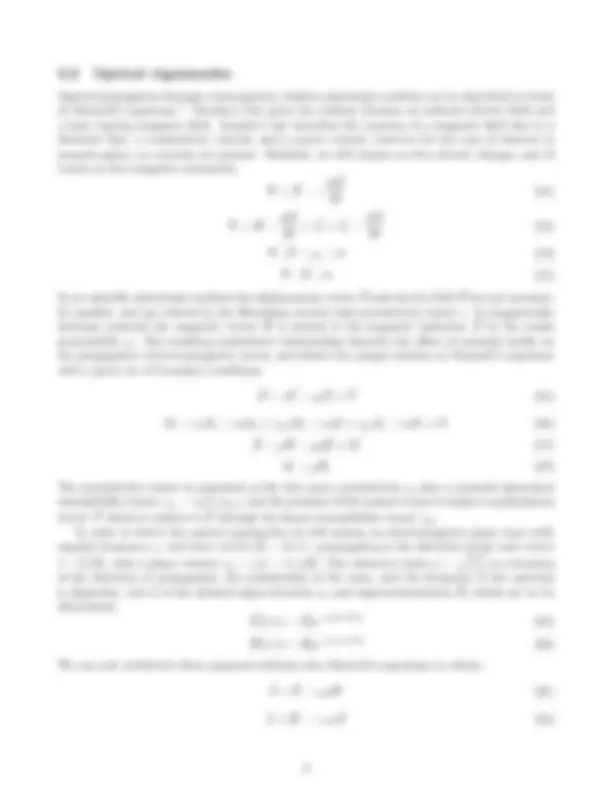
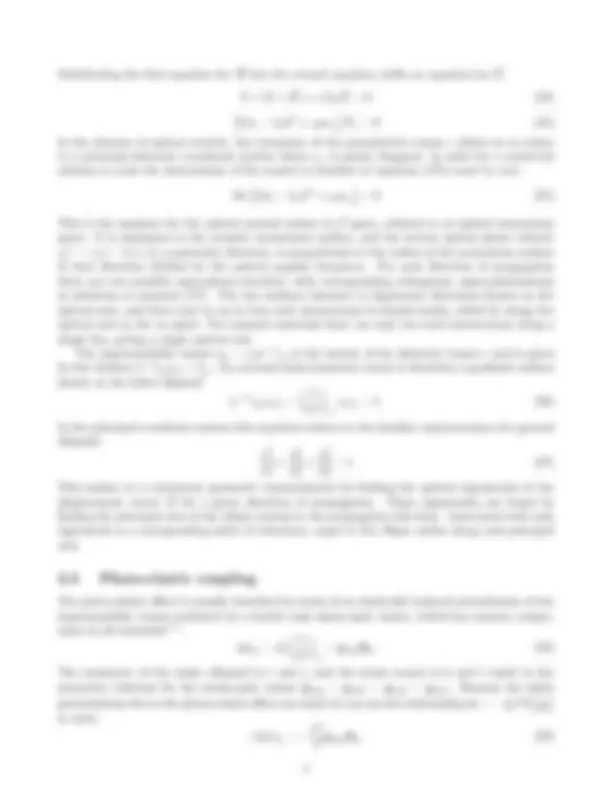
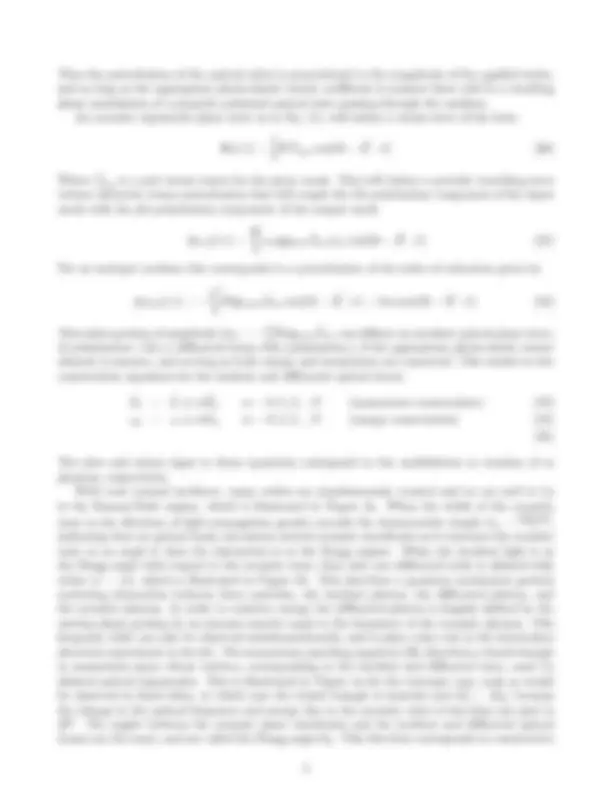
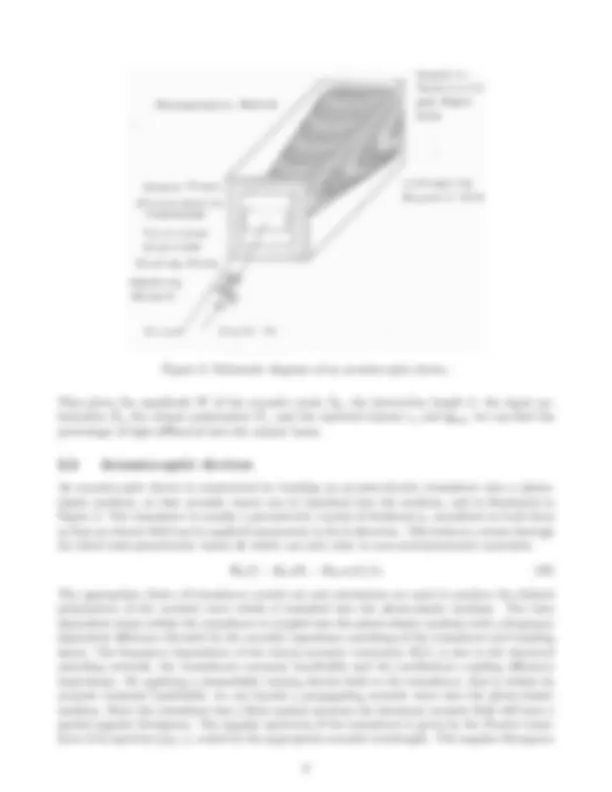
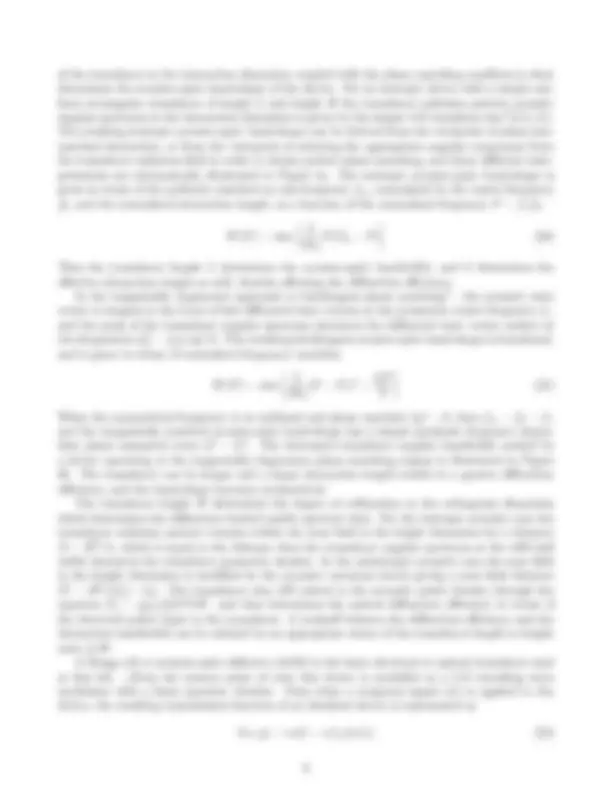
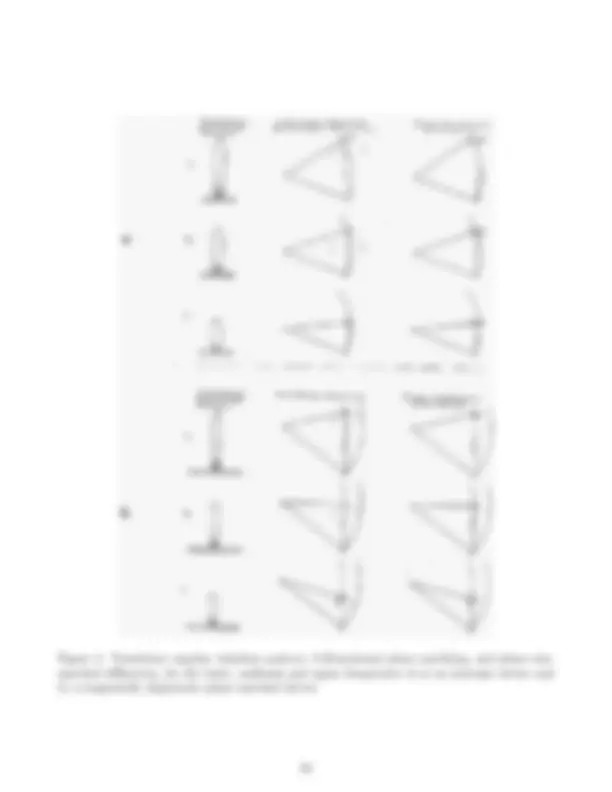
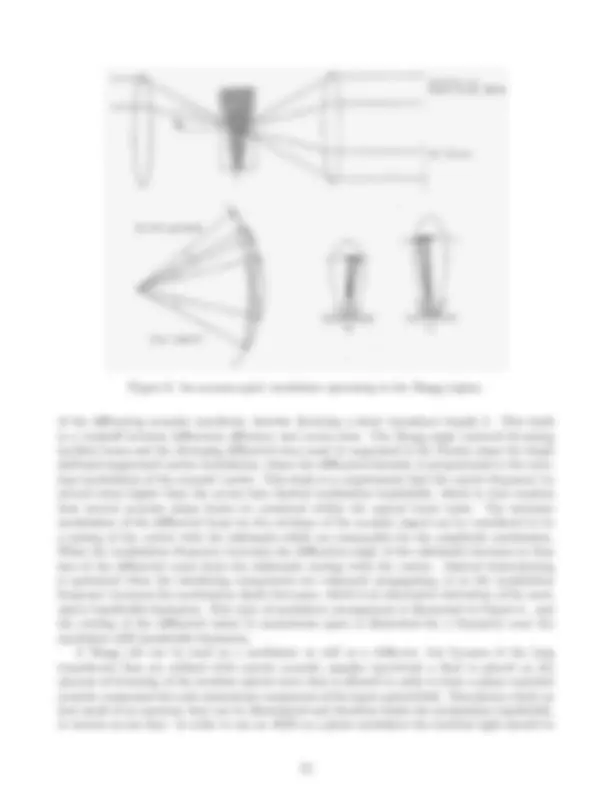
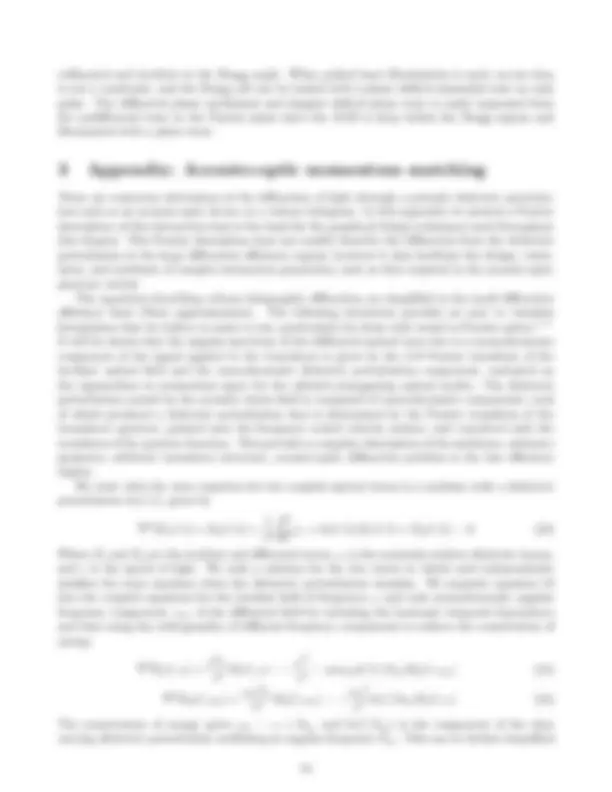
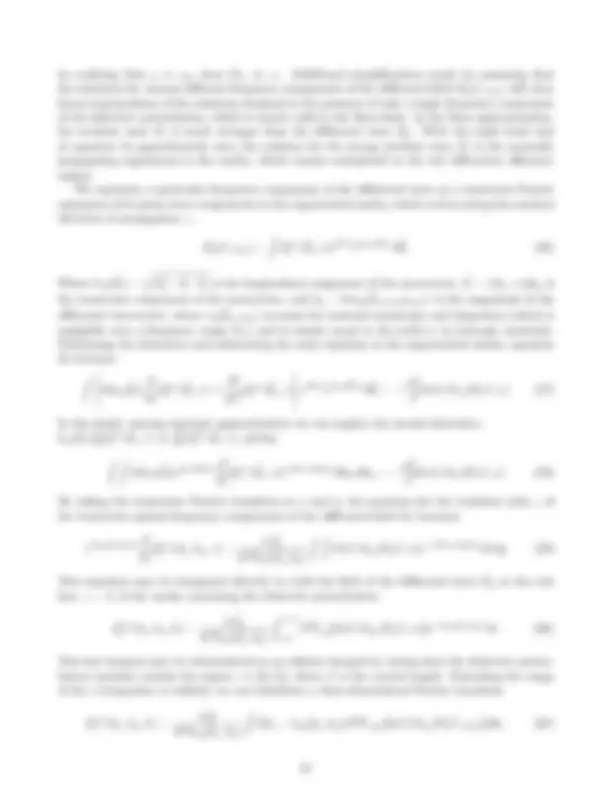
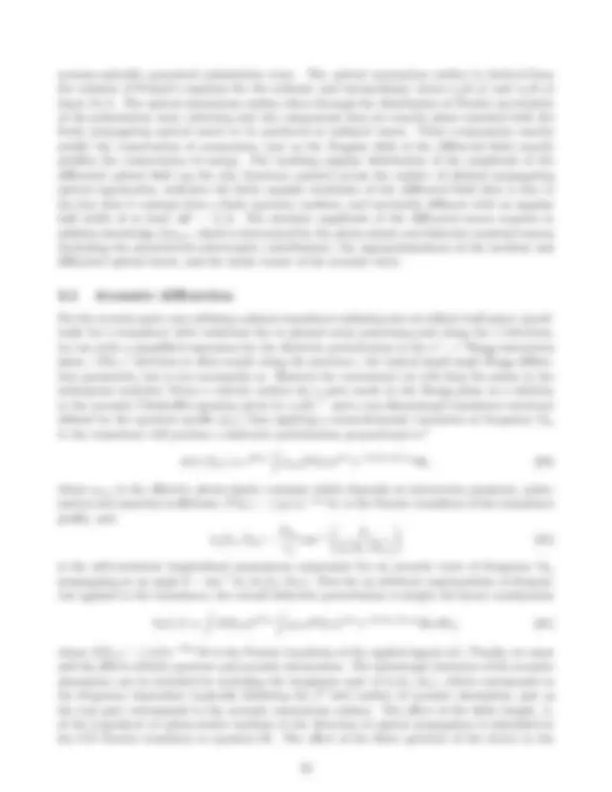
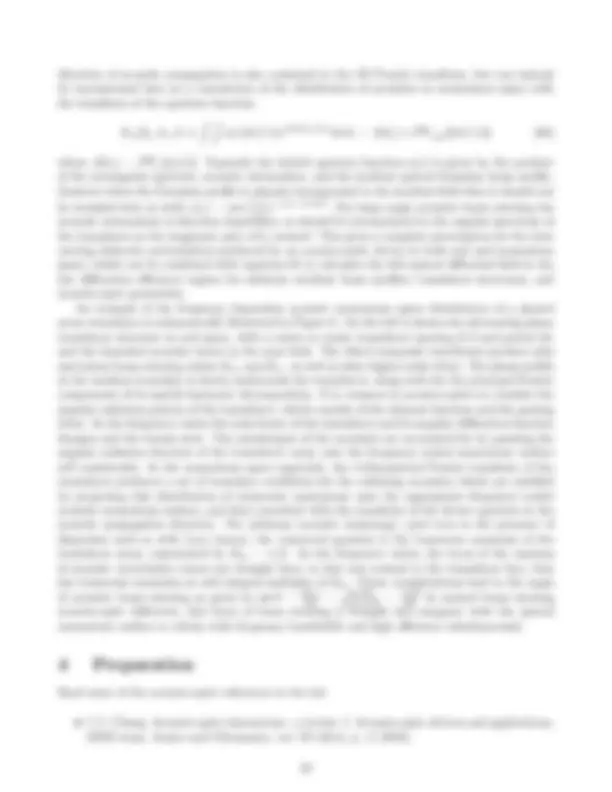
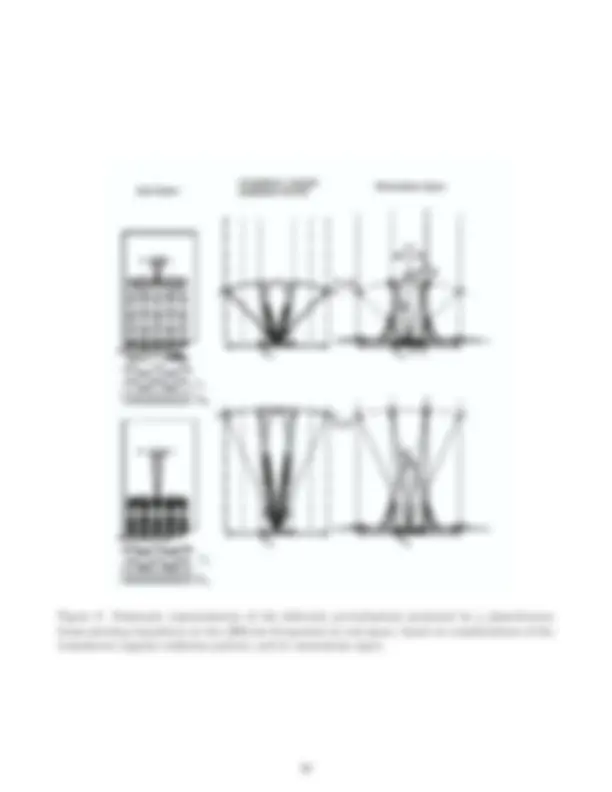
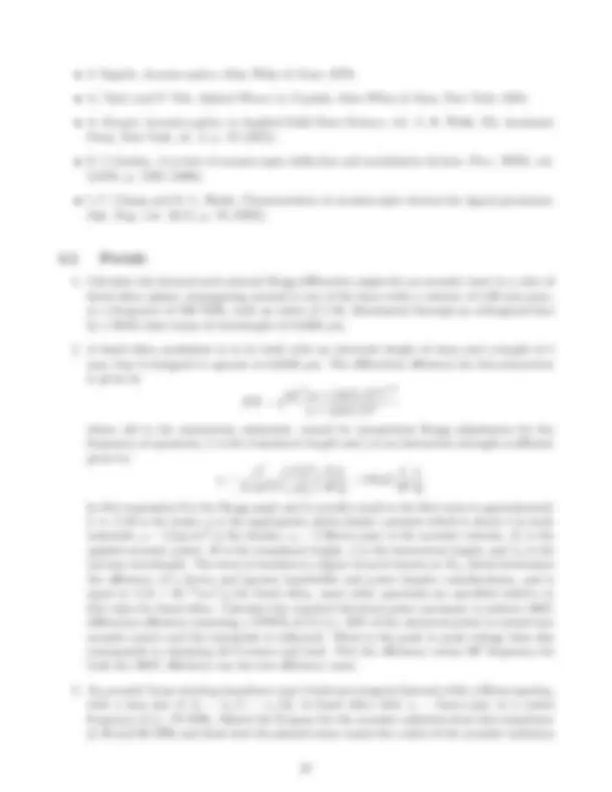
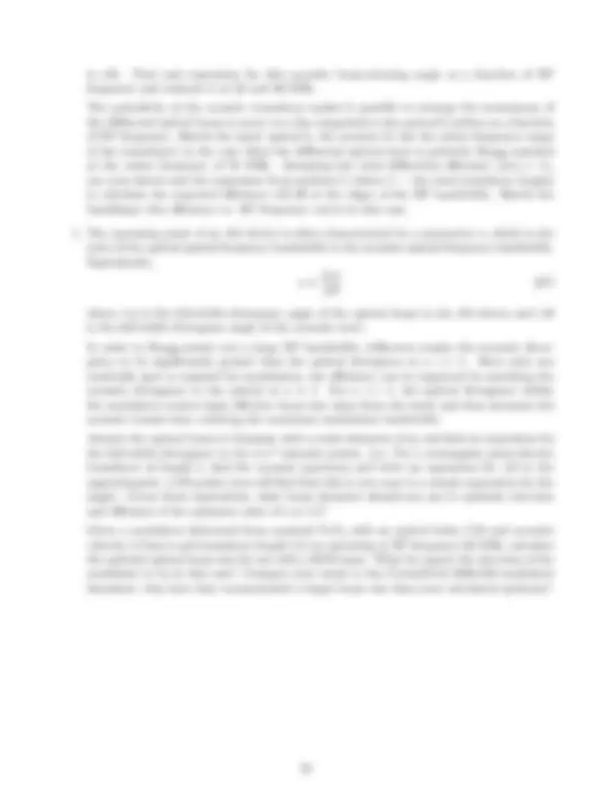
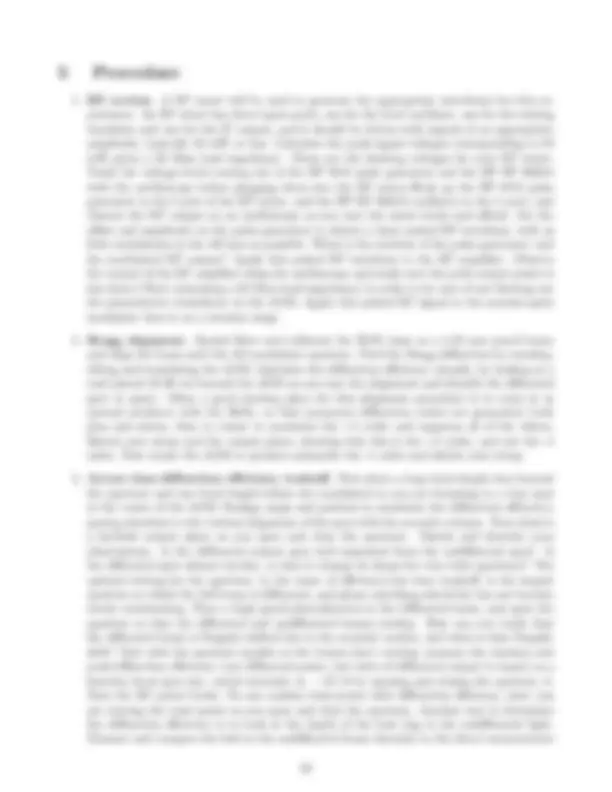
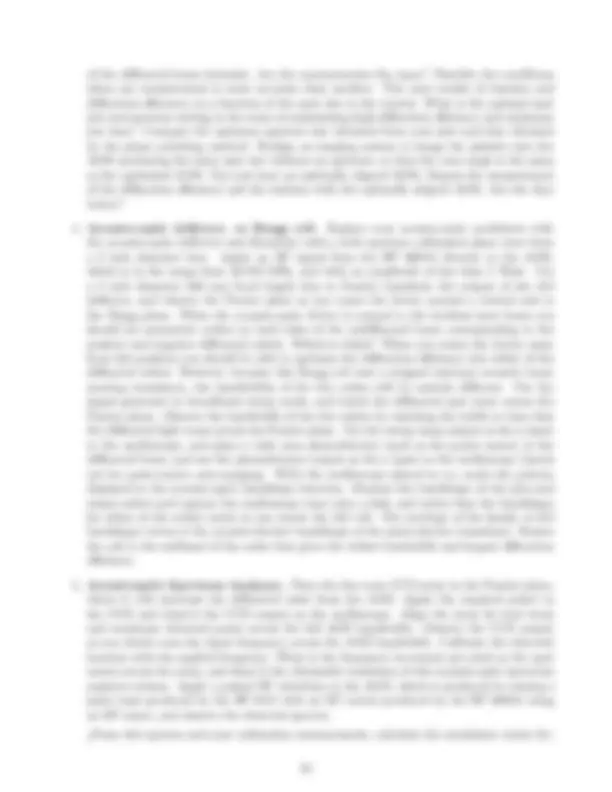
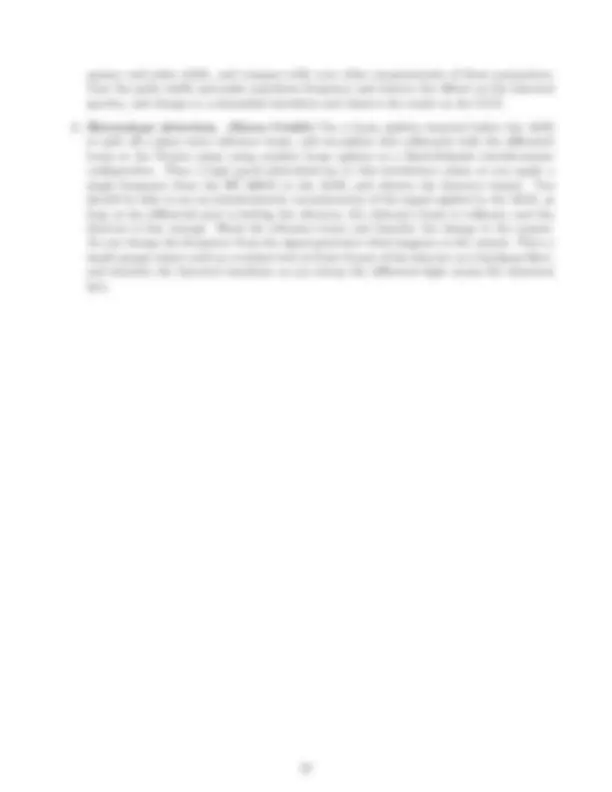


Study with the several resources on Docsity

Earn points by helping other students or get them with a premium plan


Prepare for your exams
Study with the several resources on Docsity

Earn points to download
Earn points by helping other students or get them with a premium plan
Community
Ask the community for help and clear up your study doubts
Discover the best universities in your country according to Docsity users
Free resources
Download our free guides on studying techniques, anxiety management strategies, and thesis advice from Docsity tutors
Material Type: Lab; Class: OPTICAL LAB 1; Subject: Electrical & Computer Engineering; University: University of Colorado - Boulder; Term: Unknown 1989;
Typology: Lab Reports
1 / 25

This page cannot be seen from the preview
Don't miss anything!


















Department of Electrical and Computer Engineering University of Colorado at Boulder
Kelvin Wagner
Experiment No. 13
In this lab you will learn to use acousto-optic modulators and deflectors in order to manipulate the intensity, frequency, and direction of propagation of laser wavefronts. You will optimize the operation of an acousto-optic modulator for large diffraction efficiency, and wide modulation bandwidth, and you will learn the difference between modulators and deflectors.
Acousto-optic devices are based on the periodic modulation of the optical index of refraction caused by an acoustic wave propagating in a transparent material. An optical wave passing through the region containing the acoustic wave will experience a periodic phase modulation that can produce a corrugation of the optical wavefront which will result in a scattering of the optical wave into diffracted orders. The acousto-optic interaction is somewhat different from other types of optical volume diffraction effects because the perturbation is required to be a superposition of propagating eigenmodes of the acoustic wave equation. The acousto-optic interaction results in the phase modulation of an optical beam by an acous- tic wave in a photo-elastic medium. In order to properly describe this interaction the acoustic and optical waves will be represented separately, and then the coupling between them will be introduced. This interaction is mediated by the 4th rank photo-elastic tensor which describes the dielectric impermeability tensor perturbation caused by the propagating strain wave. In practice, devices are designed to make use of only a single element of the coupling tensor, and the problem is greatly simplified.
The acoustic wave is modelled as a time and space varying particle displacement vector field ~u(~x, t), which at each crystal lattice site describes the particle displacement from its equilibrium position??^. A sinusoidal displacement wave of amplitude W , radian frequency Ω, wave vector | K~| = 2π/Λ, acoustic wavelength Λ, propagating with a phase velocity va(~s) = Ω/|K| in the direction defined by the unit vector ~s = K/~ |K|, and with unit polarization Uˆ is described by the particle displacement field
~u(~x, t) = W Uˆ cos(Ωt − K~ · ~x) = W Uˆ cos
[ Ω(t −
~s · ~x va(~s)
] (1)
The displacement gradient matrix is the spatial derivative of the displacement field, and its com- ponents are given by
Qij (~x, t) =
[ ∂ui(~x, t) ∂xj
] (2)
The symmetric part of the displacement gradient matrix is known as the linearized Strain tensor and its components are given by
Sij =
[ ∂ui ∂xj
∂uj ∂xi
] (3)
The Stress tensor Tij , which is symmetric in non-ferric materials, is related to the Strain tensor through the 4th rank elastic stiffness tensor in a generalization of Hooke’s law.
Tij = cijklSkl (4)
Where the Einstein summation convention over repeated indices is implied, and i, j, k, l may take on any of the three spatial directions x 1 , x 2 , x 3 or equivalently x, y, z. The elastic coefficients possess certain symmetries because of the symmetry of S and T, so that cijkl = cjikl = cijlk = cjilk, and energy arguments show that cijkl = cklij. The acoustic field equations show that energy oscillates between the stress energy and the strain energy in a fashion that is analogous to the electromagnetic oscillation between electric and magnetic energy. The dynamical equation of motion for a vibrating medium relates the restoring force as given by the divergence of the Stress tensor with the mass times acceleration of the displacement field.
F^ ~ = ∇ · T = ρm^ ∂
(^2) ~u ∂t^2
Fi =
∂xj
Tij = ρm
∂^2 ui ∂t^2
In this equation ρm is the scalar equilibrium mass density of the medium. Substitution of the Stress-Strain relationship, and the definition of Stress in terms of particle displacements into the dynamical equation of motion results in the differential equation governing the propagation of particle displacement fields.
Fi = cijkl
∂^2 uk ∂xl∂xj
= ρm
∂^2 ui ∂t^2
Substitution of the assumed plane wave of Equation 1 into this equation results in the equation for the allowed modes of propagation.
cijklsj slk^2 Uk = Γik(~s)k^2 Uk = ρmΩ^2 Ui (8) [ cijklsj sl/v a^2 − ρmδik
] Uk = 0 (9)
This system is only compatible for all waves if the determinant of the system is zero, which results in the dispersion relationship in terms of the Christoffel matrix Γik(~s) = cijklsj sl as a function of the propagation direction ~s, where sx, sy, sz are the appropriate direction cosines.
det
∣∣ ∣∣ ∣
Γik(~s) v^2 a
− ρmδik
∣∣ ∣∣ ∣ = 0^ (10)
This equation has three solutions for the acoustic slowness, or inverse velocity 1/va(~s) = K/~ Ω for
each direction ~s, forming three equivalent frequency scaled surfaces in K~ space, known as acoustic momentum space. The corresponding eigen-polarizations Uˆ (~s) for each direction of propagation correspond to the longitudinal (or quasilongitudinal) and two shear (or quasishear) solutions.
Substituting the first equation for H~ into the second equation yields an equation for E~.
~k × (~k × E~) + ω^2 μ≤ E~ = 0 (23) [ kikj − δij k^2 + ωμ≤ij
] Ej = 0 (24)
In the absence of optical activity, the symmetry of the permittivity tensor ≤ allows us to rotate to a principal dielectric coordinate system where ≤ij is purely diagonal. In order for a nontrivial solution to exist the determinant of the matrix in brackets in equation (17b) must be zero.
det
[ kikj − δij k^2 + ωμ≤ij
] = 0 (25)
This is the equation for the optical normal surface in ~k space, referred to as optical momentum space. It is analogous to the acoustic momentum surface, and the inverse optical phase velocity v p− 1 = n/c = k/ω in a particular direction, is proportional to the radius of the momentum surface in that direction divided by the optical angular frequency. For each direction of propagation there are two possible eigen-phase-velocities, with corresponding orthogonal, eigen-polarizations as solutions to equation (17). The two surfaces intersect in degenerate directions known as the optical axes, and there may be up to four such intersections in biaxial media, which lie along two optical axes in the xz plane. For uniaxial materials there are only two such intersections along a single line, giving a single optical axis. The impermeability tensor ηij = ≤ 0 (≤−^1 )ij is the inverse of the dielectric tensor ≤ and is given by the relation (≤−^1 )kj ≤ik = δij. As a second rank symmetric tensor it describes a quadratic surface known as the index ellipsoid
(≤−^1 )ij xixj =
( 1 n^2
)
ij
xixj = 1. (26)
In the principal coordinate system this equation reduces to the familiar representation of a general ellipsoid. x^21 n^21
x^22 n^22
x^23 n^23
This surface is a convenient geometric representation for finding the optical eigenmodes of the displacement vector D~ for a given direction of propagation. These eigenmodes are found by finding the principal axes of the ellipse normal to the propagation direction. Associated with each eigenmode is a corresponding index of refraction, equal to the ellipse radius along each principal axis.
The photo-elastic effect is usually described in terms of an elastically induced perturbation of the impermeability tensor mediated by a fourth rank elasto-optic tensor, which has nonzero compo- nents in all materials??^.
∆ηij = ∆
( 1 n^2
)
ij
= pijklSkl (28)
The symmetry of the index ellipsoid in i and j, and the strain tensor in k and l result in the symmetry relations for the strain-optic tensor pijkl = pjikl = pijlk = pjilk. Because the index
perturbations due to the photo-elastic effect are small we can use the relationship dn = − 12 n^3 d
( 1 n^2
)
to write
(∆n)ij = −
n^3 2
pijklSkl (29)
Thus the perturbation of the optical index is proportional to the magnitude of the applied strain, and as long as the appropriate photo-elastic tensor coefficient is nonzero there will be a resulting phase modulation of a properly polarized optical wave passing through the medium. An acoustic eigenmode plane wave as in Eq. (1), will induce a strain wave of the form
S(~x, t) =
W Sˆmn cos(Ωt − K~ · ~x) (30)
Where Sˆmn is a unit strain tensor for the given mode. This will induce a periodic travelling wave volume dielectric tensor perturbation that will couple the ith polarization component of the input mode with the jth polarization component of the output mode
∆≤ij (~x, t) =
≤ik(pklmn Sˆmn)≤lj cos(Ωt − K~ · ~x) (31)
For an isotropic medium this corresponds to a perturbation of the index of refraction given by
∆nij (~x, t) = −
n^3 2
W pijmn Sˆmn cos(Ωt − K~ · ~x) = δn 0 cos(Ωt − K~ · ~x). (32)
This index grating of amplitude δn 0 = −n
3 2 W^ pijmn^ Sˆmn can diffract an incident optical plane wave, of polarization i into a diffracted beam with polarization j, if the appropriate photo-elastic tensor element is nonzero, and as long as both energy and momentum are conserved. This results in two conservation equations for the incident and diffracted optical waves.
~kd = ~ki ± m K~a m = 0, 1 , 2 , ...N (momentum conservation) (33) ωd = ωi ± mΩa m = 0, 1 , 2 , ...N (energy conservation) (34) (35)
The plus and minus signs in these equations correspond to the annihilation or creation of m phonons, respectively. With near normal incidence, many orders are simultaneously created and we are said to be in the Raman-Nath regime, which is illustrated in Figure 3a. When the width of the acoustic
wave in the direction of light propagation greatly exceeds the characteristic length L 0 = nΛ
(^20) cos θ λ , indicating that an optical beam encounters several acoustic wavefronts as it traverses the acoustic wave at an angle θ, then the interaction is in the Bragg regime. When the incident light is at the Bragg angle with respect to the acoustic wave, then only one diffracted order is allowed with either m = ±1, which is illustrated in Figure 3b. This describes a quantum mechanical particle scattering interaction between three particles, the incident photon, the diffracted photon, and the acoustic phonon. In order to conserve energy the diffracted photon is doppler shifted by the moving phase grating by an amount exactly equal to the frequency of the acoustic phonon. This frequency shift can only be observed interferometrically, and it plays a key role in the heterodyne detection experiment in the lab. The momentum matching equation (26) describes a closed triangle in momentum space whose vertices, corresponding to the incident and diffracted wave, must be allowed optical eigenmodes. This is illustrated in Figure 4a for the isotropic case, such as would be observed in fused silica, in which case the closed triangle is isosceles and |~ki| = |~kd|, because the change in the optical frequency and energy due to the acoustic wave is less than one part in
equation
∇^2 E~(~x, t) − μ(≤ + δ≤(~x, t))
∂ E~(~x, t) ∂t^2
The individual fields with constant amplitudes are solutions of the unperturbed homogenous wave equation which allows us to substitute the total field and the acoustically induced dielectric per- turbation in the wave equation, and obtain for the one dimensional interaction configuration
∑
m=0, 1
E^ ˆme−i(ωmt−kxmx−kzmz)
[ ∂^2 ∂z^2
− 2 ikzm
∂z
] Am(z) (39)
≤ik(pklmn Sˆmn)≤lj
[ e−i(Ωt−Kxx−Kz^ z)^ + c.c.
] μ
∑
l=0, 1
ω^2 l Al(z) Eˆle−i(ωlt−kxlx−kzlz)^ = 0
(40)
The adiabatic condition allows us to assume that the modal amplitudes Am(z) are slowly changing in z compared to an optical wavelength so that we can neglect the second order spatial derivative. We now require that the coefficients of Eˆme−i(ωmt−kxmx−kzmz)^ vanish for m = 0, 1, in order to obtain a phase synchronous transfer of power between the modes. This requires that kx 1 x−kz 1 z = kx 0 x−kz 0 z±Kxx−Kz z and ω 1 = ω 0 ±Ω, which are the familiar momentum and energy conservation conditions. For Bragg interactions only a single order has a totally phase synchronous interaction with the input fields so we only get coupling to a single mode. This results in the well known coupled mode equations for perfectly phase matched interactions.
dA 0 (z) dz
= −iκA 1 (41) dA 1 (z) dz
= −iκ∗A 0. (42)
(43)
Where the coupling constant is found from the incident and diffracted polarization vectors left and right projected onto the dielectric perturbation tensor.
κ =
ω 4
Eˆ 0 ∗ · ∆≤ Eˆ 1 = ω 4
|E∗ 0 i ·
≤ik(pklmn Sˆmn)≤lj E 1 j | (44)
The solution of the coupled mode equation with the implied boundary condition of A 1 (0) = 0, yields the perfectly coupled mode solution for z > 0
A 0 (z) = A 0 (0) cos |κ|z, (45) A 1 (z) = −i
κ |κ|
A 0 (0) sin |κ|z. (46)
(47)
So the optical field is seen to oscillate back and forth between the incident and diffracted field each distance 2Lm = π/|κ|, as the beams propagate in the z direction. Complete power transfer occurs from the input to the diffracted mode after a distance of z propagation given by Lm. The diffraction efficiency is the ratio of the incident optical intensity to the intensity transferred to the diffracted beam in a distance L, and it is given by
I 2 I 1
= sin^2 |κ|L (48)
Figure 3: Schematic diagram of an acousto-optic device.
Thus given the amplitude W of the acoustic mode Sˆkl, the interaction length L, the input po- larization Eˆ 0 , the output polarization Eˆ 1 , and the material tensors ≤ij and pijkl, we can find the percentage of light diffracted into the output beam.
An acousto-optic device is constructed by bonding an acousto-electric transducer onto a photo- elastic medium, so that acoustic waves can be launched into the medium, and is illustrated in Figure 3. The transducer is usually a piezoelectric crystal of thickness t 0 , metalized on both faces so that an electric field can be applied transversely in the k direction. This induces a strain through the third rank piezoelectric tensor d, which can only exist in non-centrosymmetric materials.
Sij (t) = dijkEk = dijkvk(t)/t 0 (49)
The appropriate choice of transducer crystal cut and orientation are used to produce the desired polarization of the acoustic wave which is launched into the photo-elastic medium. The time dependent strain within the transducer is coupled into the photo-elastic medium with a frequency dependent efficiency dictated by the acoustic impedance matching of the transducer and bonding layers. The frequency dependence of the electro-acoustic conversion R(f ), is due to the electrical matching network, the transducers resonant bandwidth and the mechanical coupling efficiency band-shape. By applying a sinusoidally varying electric field to the transducer, that is within its acoustic resonant bandwidth, we can launch a propagating acoustic wave into the photo-elastic medium. Since the transducer has a finite spatial aperture the harmonic acoustic field will have a spatial angular divergence. The angular spectrum of the transducer is given by the Fourier trans- form of its aperture p(y, z), scaled by the appropriate acoustic wavelength. The angular divergence
Figure 4: Transducer angular radiation pattern, 2-dimensional phase matching, and phase mis- matched diffraction, for the lower, midband and upper frequencies of a) an isotropic device and b) a tangentially degenerate phase matched device.
The acoustic velocity va is taken to be the nominal velocity along the symmetry axis normal to the transducer. The window function w(x) is the product of the device finite aperture window with the acoustic attenuation, and the input optical beam gaussian profile is often included as well, thereby making the window function a hybrid window of the induced polarization field which is the product of input field and dielectric perturbation.
2.5.1 Acoustic Phased-Arrays for increased Efficiency-Bandwidth Product
Another technique used to increase the efficiency-bandwidth product of a deflector is to use a beam steering acoustic phased-array-transducer. These transducers produce a narrow angular radiation lobe, ideal for high diffraction efficiency, but generally poor for bandwidth, and then they steer this acoustic radiation lobe as the frequency is varied in the direction necessary to phase match over a wide bandwidth. Two types of phased arrays are commonly used, the constant phase delay phased arrays, and the constant time delay phased arrays, and these are illustrated in Figure 5. A constant phase delay of 180 degrees between adjacent transducer array elements can be accomplished by applying the RF to alternate transducers which lie on top of a voltage dividing floating ground plane. Such an array produces two main acoustic lobes which both steer towards the normal as the frequency is increased. Only one of these lobes is utilized in a typical beam steering acousto-optic device, and the power in the other lobe is wasted. When 3 RF phases 120 degrees apart are used to drive 3 alternating transducer phases, then only one main acoustic beam is produced, thereby doubling the efficiency of such a device, however the complexity of 120 degree hybrids detracts from the attractiveness of this scheme. An alternate approach to producing a single acoustic beam which steers with frequency is the constant time delay phased array implemented as a stepped staircase transducer, where the step size is half the midband acoustic wavelength Λc/2 as illustrated in Figure 5b. In both of these beam steering techniques the locus of acoustic momentum vectors trace out a straight line orthogonal to the transducer, but offset by the fundamental grating frequency of the transducer, so that the resulting acoustic momentum vector is given by K~a = 2πva/f ˆz + π/dxˆ, where f is the applied frequency, d is the width of each phased array element, and ˆx is in the direction of the transducer elements. As the Bragg cell is rotated this locus of acoustic beams is brought into tangency with the optical momentum surface, in an analogous manner as in anisotropic diffraction, thereby maintaining a small phase mismatch over a wide bandwidth because of the quadratic deviation from perfect phase matching. However, when such a beam steering array is rotated to the other Bragg angle, then the locus of acoustic momentum vectors cuts through the optical momentum surface with a linear dependence of the momentum mismatch on frequency, seriously degrading the bandwidth for that order.
Another important device is the acousto-optic point modulator or AOM, which is similarly con- structed by bonding an acousto-electric transducer to a photo-elastic medium. The principal difference between an AOM and an AOD is that the AOM is used with a tightly focussed optical spot incident on the center of the acoustic column and the AOD is illuminated with a collimated wave. This is because the modulator must have a quick access time in order to achieve wide modulation bandwidth, which is the inverse of the acoustic propagation time across the beam waist of the focussed spot?^. In order to be able to modulate each spatial frequency component of the focussed optical field there must be a corresponding phase matched frequency component
Figure 6: An acousto-optic modulator operating in the Bragg regime.
of the diffracting acoustic wavefront, thereby dictating a short transducer length L. This leads to a tradeoff between diffraction efficiency and access time. The Bragg angle centered focussing incident beam and the diverging diffracted wave must be separated in the Fourier plane for single sideband suppressed carrier modulation, where the diffracted intensity is proportional to the enve- lope modulation of the acoustic carrier. This leads to a requirement that the carrier frequency be several times higher than the access time limited modulation bandwidth, which in turn requires that several acoustic phase fronts be contained within the optical beam waist. The intensity modulation of the diffracted beam by the envelope of the acoustic signal can be considered to be a mixing of the carrier with the sidebands which are responsible for the amplitude modulation. When the modulation frequency increases the diffraction angle of the sidebands increases so that less of the diffracted cones from the sidebands overlap with the carrier. Optical heterodyning is optimized when the interfering components are colinearly propagating, so as the modulation frequency increases the modulation depth decreases, which is an alternative derivation of the mod- ulator bandwidth limitation. This type of modulator arrangement is illustrated in Figure 6 , and the overlap of the diffracted waves in momentum space is illustrated for a frequency near the modulator 3dB bandwidth limitation. A Bragg cell can be used as a modulator as well as a deflector, but because of the long transducers that are utilized with narrow acoustic angular spectrums a limit is placed on the amount of focussing of the incident optical wave that is allowed in order to have a phase matched acoustic component for each momentum component of the input optical field. This places a limit on how small of an aperture that can be illuminated and therefore limits the modulation bandwidth, or inverse access time. In order to use an AOD as a phase modulator the incident light should be
collimated and incident at the Bragg angle. When pulsed laser illumination is used, access time is not a constraint, and the Bragg cell can be loaded with a phase shifted sinusoidal tone on each pulse. The diffracted phase modulated and doppler shifted plane wave is easily separated from the undiffracted wave in the Fourier plane since the AOD is deep within the Bragg regime and illuminated with a plane wave.
3 Appendix: Acousto-optic momentum matching
There are numerous derivations of the diffraction of light through a periodic dielectric perturba- tion such as an acousto-optic device or a volume hologram. In this appendix we present a Fourier description of this interaction that is the basis for the graphical design techniques used throughout this chapter. This Fourier description does not readily describe the diffraction from the dielectric perturbation in the large diffraction efficiency regime, however it does facilitate the design, evalu- ation, and synthesis of complex interaction geometries, such as that required in the acousto-optic photonic switch. The equations describing volume holographic diffraction are simplified in the small diffraction efficiency limit (Born approximation). The following derivation provides an easy to visualize formulation that we believe is easier to use, particularly for those well versed in Fourier optics.?? It will be shown that the angular spectrum of the diffracted optical wave due to a monochromatic component of the signal applied to the transducer is given by the 3-D Fourier transform of the incident optical field and the monochromatic dielectric perturbation component, evaluated on the eigensurface in momentum space for the allowed propagating optical modes. The dielectric perturbation caused by the acoustic strain field is composed of monochromatic components, each of which produces a dielectric perturbation that is determined by the Fourier transform of the transducer aperture, painted onto the frequency scaled velocity surface, and convolved with the transform of the aperture function. This provides a complete description of the multitone, arbitrary geometry, arbitrary transducer structure, acousto-optic diffraction problem in the low efficiency regime. We start with the wave equation for two coupled optical waves in a medium with a dielectric perturbation δ≤(~r, t), given by
∇^2 [Ei(~r, t) + Ed(~r, t)] +
c^2
∂t^2
[≤r + δ≤(~r, t)][Ei(~r, t) + Ed(~r, t)] = 0 (53)
Where Ei and Ed are the incident and diffracted waves, ≤r is the materials relative dielectric tensor, and c is the speed of light. We seek a solution for the two waves in which each independently satisfies the wave equation when the dielectric perturbation vanishes. We separate equation 53 into the coupled equations for the incident field of frequency ω and each monochromatic angular frequency component, ωm, of the diffracted field by including the harmonic temporal dependence and then using the orthogonality of different frequency components to enforce the conservation of energy.
∇^2 Ei(~r, ω) +
ω^2 ≤r c^2
Ei(~r, ω) = −
ω^2 c^2
= summδ≤∗(~r, Ωm)Ed(~r, ωm) (54)
∇^2 Ed(~r, ωm) +
ωm^2 ≤r c^2
Ed(~r, ωm) = −
ωm^2 c^2
δ≤(~r, Ωm)Ei(~r, ω) (55)
The conservation of energy gives ωm = ω + Ωm, and δ≤(~r, Ωm) is the component of the time varying dielectric perturbation oscillating at angular frequency Ωm. This can be further simplified
This is our key result. It states that the angular spectrum components of the diffracted field at the output of the media containing the weak dielectric perturbations is given by the 3-D Fourier transform of the product of the incident field and the dielectric perturbation, evaluated on the surface of the allowed propagating modes for the diffracted field. In this formulation both momentum and energy are conserved exactly, which is in contrast to most other treatments which consider momentum mismatch to be a violation of momentum conservation rather than a decrease of the Fourier amplitude of a finite dielectric perturbation as shown above. It should be noted that kzd(~kt) is linearly dependent on the frequency of the diffracted beam (neglecting dispersion), so that the sampling ellipsoidal momentum surface represented by the δ function grows proportional to the diffracted beams frequency. However, this effect is very small for acousto-optics, Ωm/ω < 10 −^6 , and can often be safely treated as a single sampling surface cutting through the uncertainty distribution of the product of the incident wave and the dielectric perturbation. Some of the key concepts of this derivation are presented in Figure 7. The acousto-optically induced polarization responsible for radiating the diffracted field is, in the Born limit, given by the product of the incident optical field and the perturbing acoustic field. For an infinite medium illuminated by a single incident plane wave and containing a single infinite acoustic plane wave perturbation the resulting acousto-optically generated polarization is given by
P^ ~ AO(~r, t) = ≤ 0 ¯¯≤r p¯¯¯¯ Ae¯¯i K~·~re−iΩt^ E~iei~k·~re−iωt^ ¯≤¯r ∝ ei(~k+^ K~)·~re−i(ω+Ω)t^ (62)
where ¯¯≤r is the relative dielectric tensor, ¯¯¯¯p is the 4th rank photo-elastic tensor, E~i is the inci- dent optical field polarization, and A¯¯ is the acoustic strain tensor. This equation shows that the wavevector of the acousto-optically generated polarization field is given by the sums of the wavevectors of the incident and perturbation fields, and the frequency of this travelling polariza- tion field is given by the sums of their respective frequencies. Graphically this can be represented as a momentum of the polarization field which is given by the vector sum of the momentums of the incident and acoustic fields. Multiple simultaneous acoustic waves with different K-vectors will each produce a polarization field with the corresponding vector sum of the momentums of the contributing fields as shown in the figure as two vector sum triangles. For finite materials and finite aperture incident beams and acoustic perturbation fields, the problem can be decomposed into individual Fourier components. This is accomplished with the 3-D Fourier transform of the product of the unperturbed incident field and the dielectric perturbation used in equation 61. This is illustrated in 2-D in the middle of figure 7 for the case of a rectangular profile incident beam of width A interacting with a rectangular boundary acoustic perturbation of width L. The Fourier transform of the product of these two rectangular boundaries produce a 2- dimensional (possibly skewed) sinc distribution of Fourier uncertainty, representing the amplitude and phase of all of the individual infinite plane wave Fourier components that must be combined to produce the spatially finite polarization field. In this case this sinc distribution has a half power width (actually ≈4dB width) given by ∆kz = 2π/L and a height given by ∆kx = 2π/A. Although there are numerous sidelobes extending to infinity in Fourier space, most of the power in the acousto-optically generated polarization wave is contained within the (^2) Lπ × (^2) Aπ “uncertainty box” which is a useful abstraction and shorthand representation of the full Fourier distribution of uncertainty used throughout this chapter. At a particular incidence angle, illustrated in the bottom of the figure, the relative amplitude and angular distribution of the diffracted optical field is given by the intersection of the momentum surface of freely propagating optical waves with the distribution of Fourier uncertainty of the
Figure 7: Graphical representation of the steps in the derivation of the diffracted field using a pictorial representation of momentum space.
direction of acoustic propagation is also contained in the 3D Fourier transform, but can instead be incorporated here as a convolution of the distribution of acoustics in momentum space with the transform of the aperture function.
δ≤A(kx, kz , t) ∝
∫ ∫ a(z)δ≤(~r, t)ei^2 π(xkxzkz^ )dxdz = A(kz ) ∗ FT (^) xyz {δ≤(~r, t)} (66)
where A(kx) = FT (^) x{a(x)}. Typically the hybrid aperture function a(x) is given by the product of the rectangular aperture, acoustic attenuation, and the incident optical Gaussian beam profile, (however when the Gaussian profile is already incorporated in the incident field then it should not
be included here as well) a(z) = rect
[ z A
] e−α(z−A/2)f^ 2
. For large angle acoustic beam steering the acoustic attenuation is direction dependent, so should be incorporated in the angular spectrum of the transducer as the imaginary part of kx instead. This gives a complete prescription for the time varying dielectric perturbation produced by an acousto-optic device in both real and momentum space, which can be combined with equation 61 to calculate the full optical diffracted field in the low diffraction efficiency regime for arbitrary incident beam profiles, transducer structures, and acousto-optic geometries. An example of the frequency dependent acoustic momentum space distribution of a phased array transducer is schematically illustrated in Figure 8. On the left is shown the alternating phase transducer structure in real space, with a center to center transducer spacing of d and period 2d, and the launched acoustic waves in the near field. The tilted composite wavefronts produce plus and minus beam steering orders Ka+ and Ka− as well as other higher order lobes. The phase profile at the medium boundary is shown underneath the transducer, along with the the principal Fourier components of its spatial harmonic decomposition. It is common in acousto-optics to consider the angular radiation pattern of the transducer, which consists of the element function and the grating lobes. As the frequency varies the scale factor of the transducer and its angular diffraction function changes and the beams steer. The anisotropies of the acoustics are accounted for by painting the angular radiation function of the transducer array onto the frequency scaled momentum surface self consistently. In the momentum space approach, the 1-dimensional Fourier transform of the transducer produces a set of boundary conditions for the radiating acoustics which are satisfied by projecting this distribution of transverse momentum onto the appropriate frequency scaled acoustic momentum surface, and then convolved with the transform of the device aperture in the acoustic propagation direction. For arbitrary acoustic anisotropy, (and even in the presence of dispersion such as with Love waves), the conserved quantity is the transverse momenta of the transducer array, represented by Kbs = π/d. As the frequency varies, the locus of the maxima of acoustic uncertainty traces out straight lines, in this case normal to the transducer face, that has transverse momenta as odd integral multiples of Kbs. These considerations lead to the angle of acoustic beam steering as given by sin θ = | |KKbsa|| = (^2) πf /v^2 π/^2 ad(θ) = v 2 adf(θ ) In normal beam steering acousto-optic deflectors, this locus of beam steering is brought into tangency with the optical momentum surface to obtain wide frequency bandwidth and high efficiency simultaneously.
4 Preparation
Read some of the acousto-optic references in the lab
Figure 8: Schematic representation of the dielectric perturbations produced by a phased-array beam-steering transducer at two different frequencies in real space, based on considerations of the transducers angular radiation pattern, and in momentum space.